Filipino Chicken Adobo
This post may contain affiliate links. Read my full disclosure policy.
An iconic Filipino dish, chicken adobo features succulent chicken simmered in a sauce of vinegar, soy sauce, garlic, bay leaves, black pepper, and creamy coconut milk.
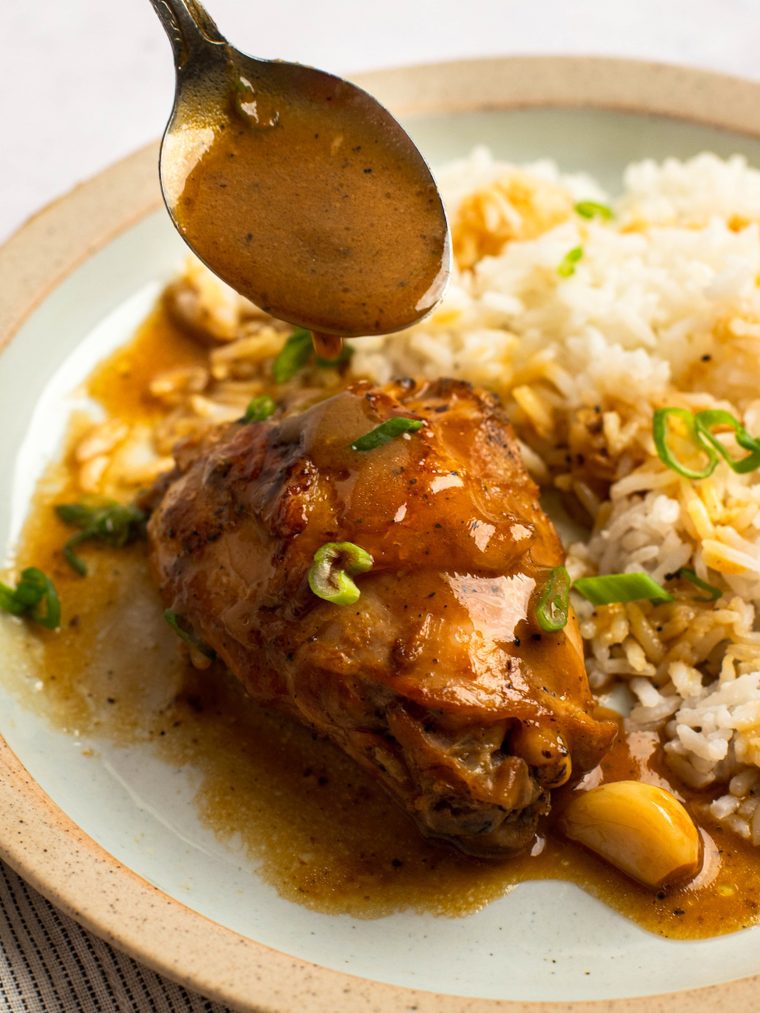
Adobo is a beloved dish in the Philippines that involves simmering meat in a tangy sauce made with vinegar, soy sauce, garlic, bay leaves, and black pepper. There are many ways to make adobo, but my personal favorite is a regional variation made with chicken and coconut milk, inspired by Filipino Chef Romy Dorotan from Purple Yam in Brooklyn. The addition of coconut milk helps to balance the tanginess of the vinegar while adding a creamy texture to the sauce. The dish remains tangy, but the flavors are all in harmony, making it a delicious and satisfying meal.
To enjoy chicken adobo at its best, serve it over a bed of fragrant jasmine rice to soak up the luscious sauce, and add a vegetable, such as roasted carrots or roasted asparagus, to complete the dish. Whether you’re a fan of Filipino cuisine or just looking for a new and exciting recipe to try, chicken adobo is sure to impress!
Table of Contents
“This dish was absolutely amazing. Such wonderful flavor and the recipe was so easy to follow.”
What You’ll Need To Make Chicken Adobo
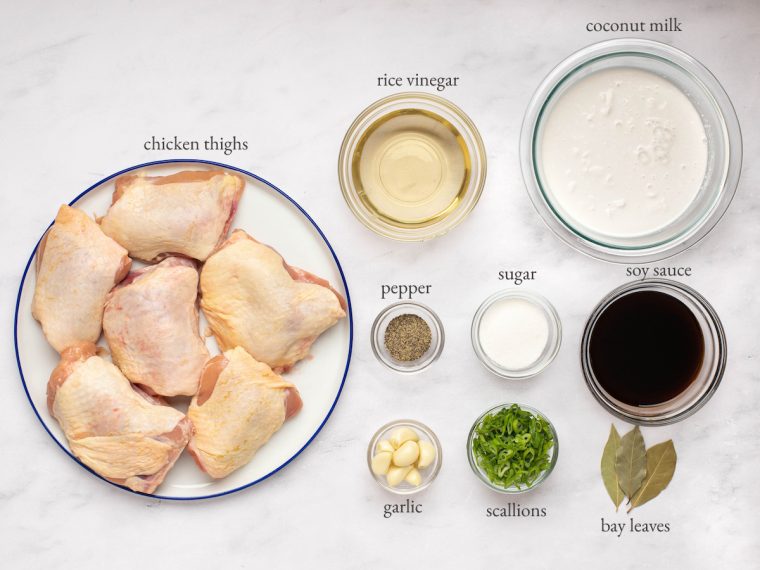
- Chicken thighs: Bone-in, skin-on thighs are preferred for their ability to stay juicy and flavorful, especially when cooked using the slow simmering method.
- Soy sauce: Acts as the salty base of the adobo marinade, contributing depth and umami to the dish.
- Coconut milk: Adds creaminess and a subtle sweetness, balancing the savory and acidic components of the marinade.
- Rice or cider vinegar: Introduces acidity to the dish, tenderizing the chicken and adding a bright contrast to the richness of the coconut milk and soy sauce.
- Garlic: A generous amount of garlic cloves infuse the dish with a pungent aroma and flavor, a key component in the depth of adobo’s taste profile.
- Bay leaves: Add a distinctive fragrance and herbal note.
- Scallions: Also known as green onions or spring onions, scallions provide a mild, slightly sweet onion flavor that enhances the dish without overwhelming the other flavors.
- Jump to the printable recipe for precise measurements
Step-by-Step Instructions
Begin by trimming the chicken thighs: cut off any excess fat or flaps of skin with kitchen shears (it’s much easier than using a knife). Marinate the chicken in the soy sauce for about an hour.
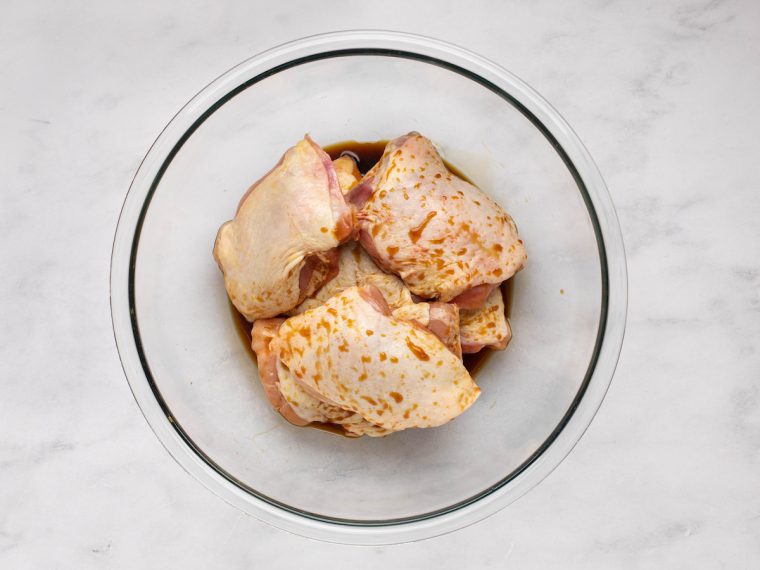
Next, sear the chicken, skin side down, in a skillet for about ten minutes.
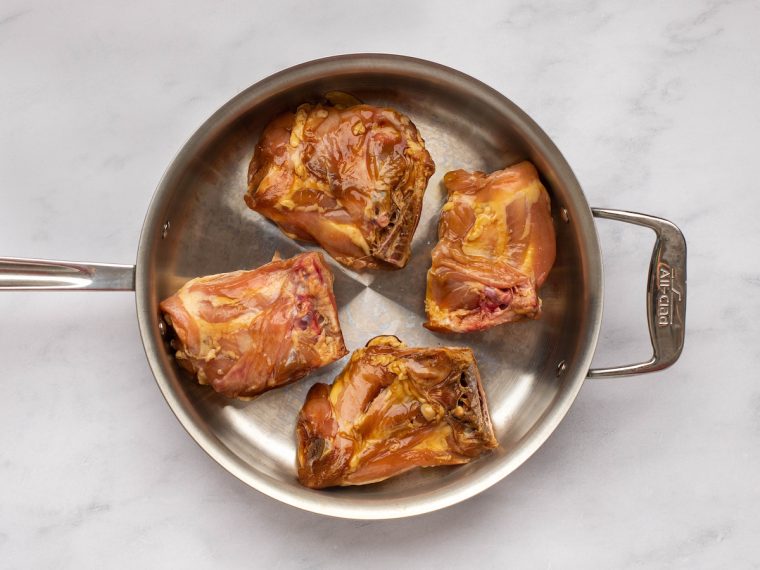
The skin will become crisp and turn a rich brown color. Set the chicken aside.
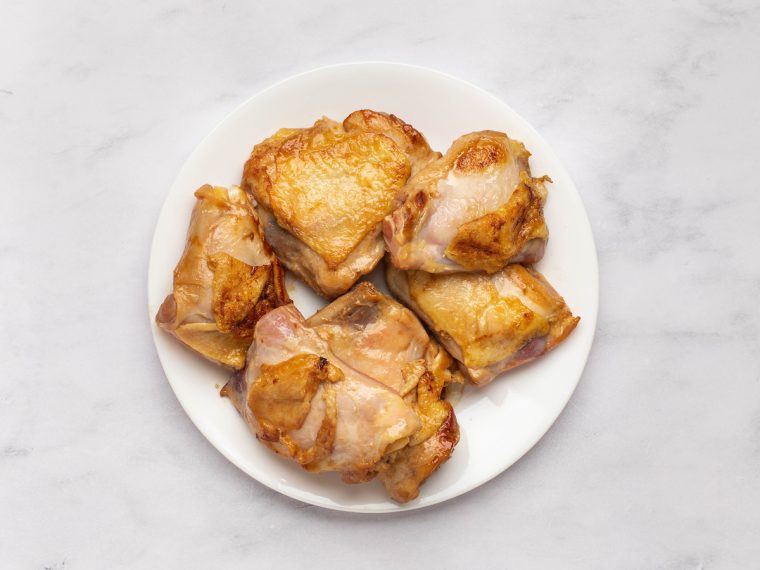
Whisk the coconut milk, vinegar, sugar and pepper into the soy sauce.
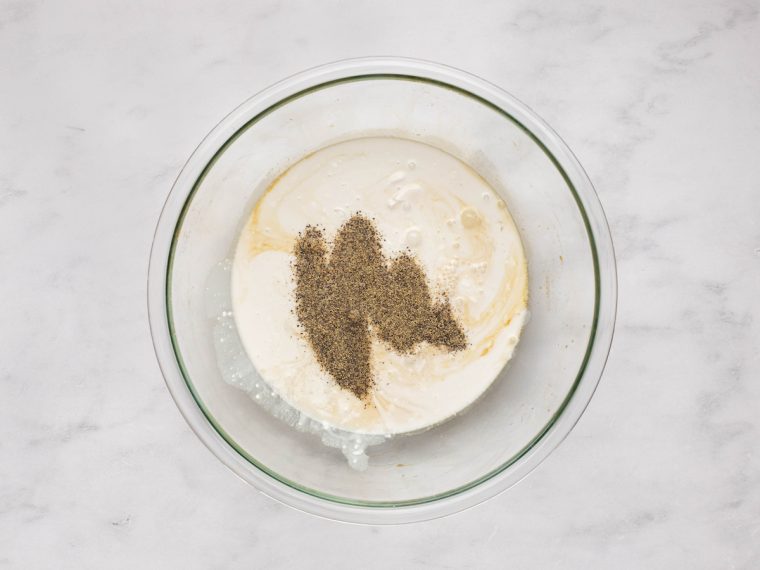
Discard the fat and wipe the pan clean. Then add the sauce to the pan.
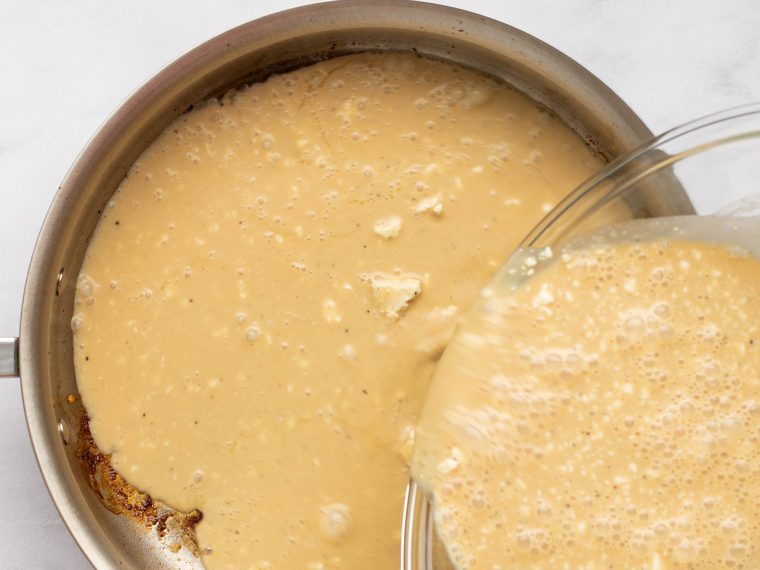
Add the garlic and bay leaves.
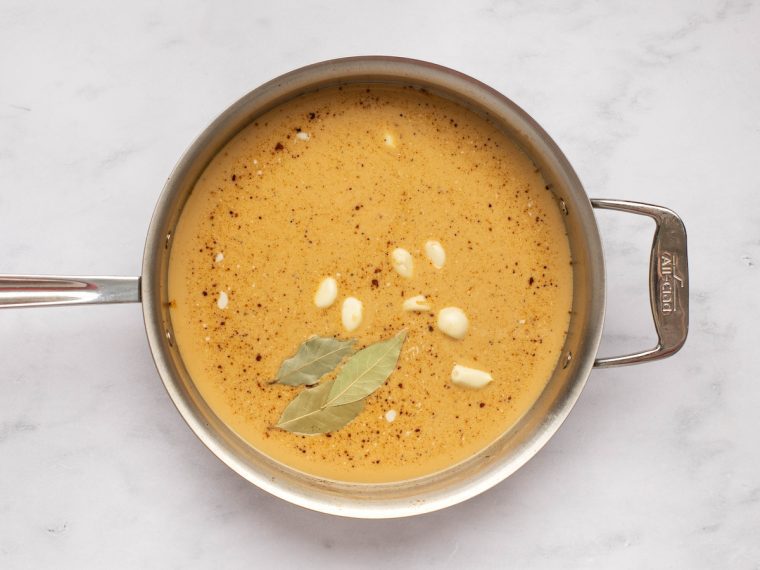
Place the chicken in the sauce, skin side up, and bring to a boil. Reduce the heat and simmer, uncovered, until the chicken is cooked through, about 35 minutes.
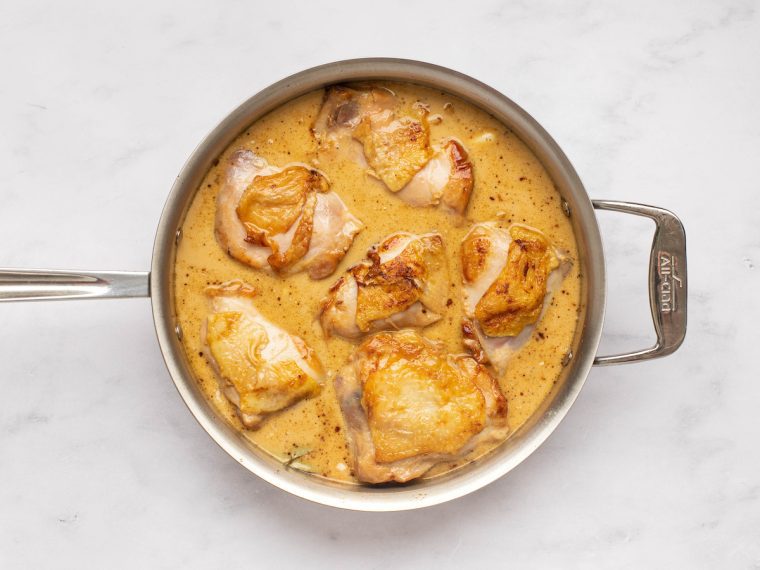
Transfer the chicken to a platter and reduce the sauce until thickened. Then place the chicken back into the sauce (or pour the sauce over the chicken on a platter) and scatter with scallions.
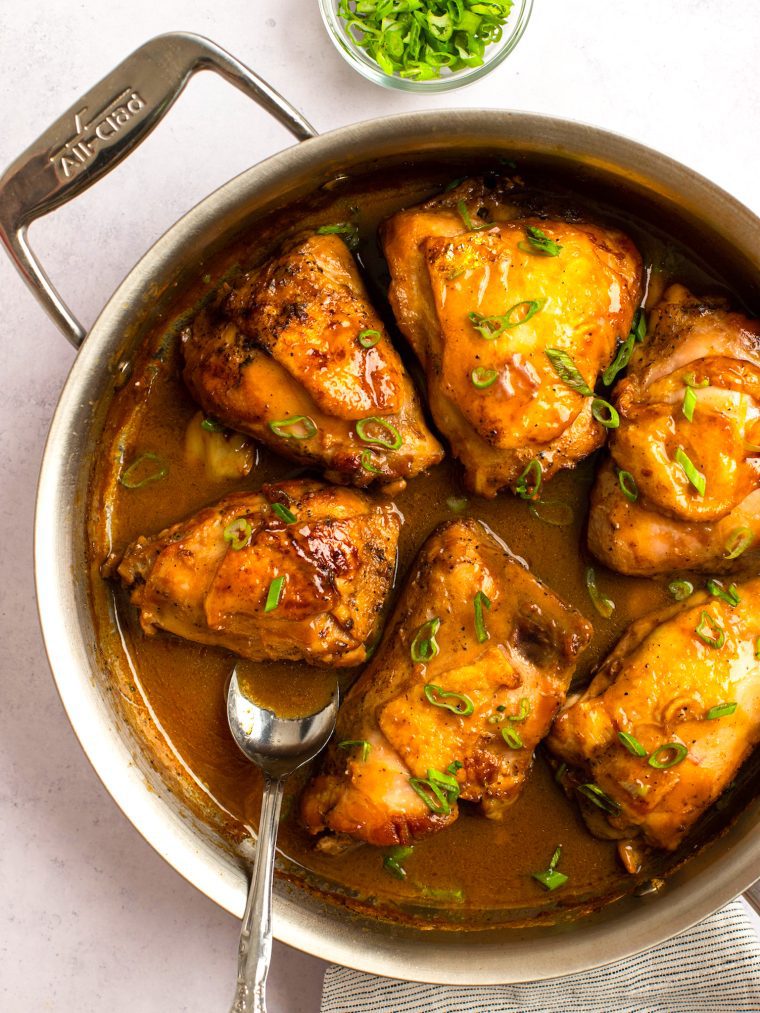
Frequently Asked Questions
Absolutely! Drumsticks, similar to thighs, are rich in flavor and stay tender during cooking, making them a great alternative. While you can use chicken breasts, it’s best to opt for bone-in, skin-on breasts to maintain moisture and flavor. I don’t recommend boneless skinless chicken breasts, as they will become dry and tough with this cooking method.
Yes, this dish is wonderful when prepared ahead of time. The flavors have more time to meld together, enhancing the overall taste. For the best results after reheating, transfer the chicken to a foil-lined baking sheet, skin side up, and quickly crisp the skin under the broiler. This step ensures that the chicken retains its delightful texture and flavor, making it just as satisfying as when it’s freshly made.
Yes, chicken adobo freezes well. Allow the dish to cool completely before transferring it to airtight freezer-safe containers. It can be stored in the freezer for up to 3 months. When you’re ready to enjoy it, thaw it in the refrigerator overnight and reheat gently on the stove, following the crisping method under the broiler (explained above) if desired.

Video Tutorial
You may also like
Filipino Chicken Adobo
An iconic Filipino dish, chicken adobo features succulent chicken simmered in a sauce of vinegar, soy sauce, garlic, bay leaves, black pepper, and creamy coconut milk.
Ingredients
- 3½ pounds bone-in chicken thighs (6-8), trimmed (see substitutions note below)
- ½ cup soy sauce (use gluten-free if needed)
- 1 (13.5 oz) can coconut milk
- ½ cup rice or cider vinegar
- 2 tablespoons sugar
- 1¼ teaspoons freshly ground black pepper
- 8 garlic cloves, peeled
- 3 bay leaves
- 3 scallions, green parts only, thinly sliced
- White rice, for serving
Instructions
- Toss the chicken with the soy sauce in a large, shallow bowl. Refrigerate for 1 hour.
- Remove the chicken from the soy sauce, allowing the excess to drip back into the bowl. Transfer the chicken, skin side down, to a cold 12-inch nonstick skillet. Set the soy sauce aside.
- Place the skillet over medium-high heat and cook until the skin is crisp and dark golden, 8-10 minutes. While the chicken is browning, whisk the coconut milk, vinegar, sugar and pepper into the soy sauce.
- Transfer the chicken to a plate and discard the fat in the skillet. Wipe the pan clean with a paper towel. Pour the soy sauce-coconut milk mixture into the pan; add the garlic and bay leaves. Return the chicken to the skillet, skin side up, and bring to a gentle boil. Reduce the heat to low and simmer, uncovered, for about 35 minutes, or until the chicken registers 175 degrees. Transfer the chicken to a platter and keep warm by tenting loosely with aluminum foil.
- Fish out the bay leaves and skim any noticeable fat off the surface of the sauce. Return the skillet to medium-high heat and cook until the sauce is slightly thickened, about 5 minutes. Taste and adjust seasoning if necessary (if it is too assertive, add a few tablespoons of water and/or a bit more sugar). Pour the sauce over the chicken and sprinkle with the scallions. Serve with rice. (Note: if you'd like the skin to be extra crispy, place the chicken breasts on a baking sheet and broil for a few minutes before serving.)
- Note: Drumsticks, similar to chicken thighs in terms of flavor and juiciness, are a great alternative. If you'd like to use white meat, use bone-in, skin-on chicken breasts. If you'd like to use boneless, skinless chicken thighs, skip the first cooking step of searing the skin, and reduce the simmering time to about 20 minutes.
- Make-Ahead Instructions: This dish is wonderful prepared ahead of time. After reheating, transfer the chicken to a foil-lined baking sheet, skin side up, and quickly crisp the skin under the broiler.
Pair with
Nutrition Information
Powered by ![]()
- Per serving (6 servings)
- Calories: 752 g
- Fat: 58 g
- Saturated fat: 24 g
- Carbohydrates: 10 g
- Sugar: 5 g
- Fiber: 1 g
- Protein: 47 g
- Sodium: 1392 mg
- Cholesterol: 259 mg
This website is written and produced for informational purposes only. I am not a certified nutritionist and the nutritional data on this site has not been evaluated or approved by a nutritionist or the Food and Drug Administration. Nutritional information is offered as a courtesy and should not be construed as a guarantee. The data is calculated through an online nutritional calculator, Edamam.com. Although I do my best to provide accurate nutritional information, these figures should be considered estimates only. Varying factors such as product types or brands purchased, natural fluctuations in fresh produce, and the way ingredients are processed change the effective nutritional information in any given recipe. Furthermore, different online calculators provide different results depending on their own nutrition fact sources and algorithms. To obtain the most accurate nutritional information in a given recipe, you should calculate the nutritional information with the actual ingredients used in your recipe, using your preferred nutrition calculator.
Gluten-Free Adaptable Note
To the best of my knowledge, all of the ingredients used in this recipe are gluten-free or widely available in gluten-free versions. There is hidden gluten in many foods; if you're following a gluten-free diet or cooking for someone with gluten allergies, always read the labels of your ingredients to verify that they are gluten-free.

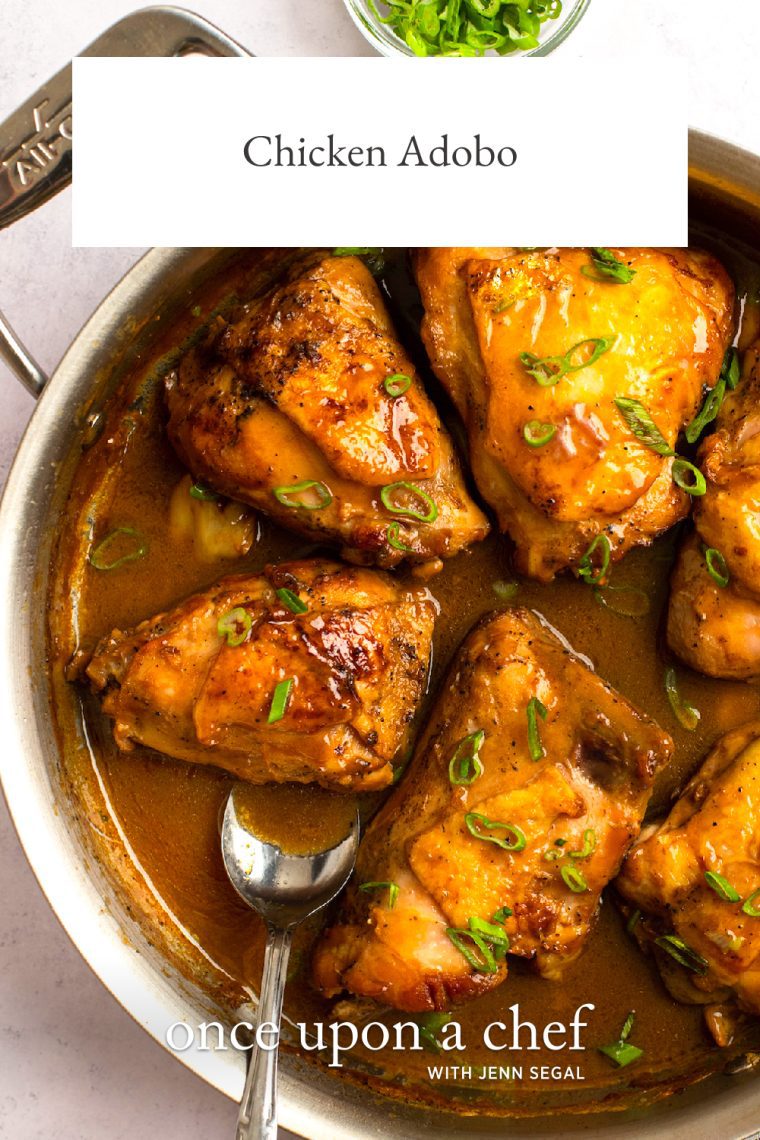


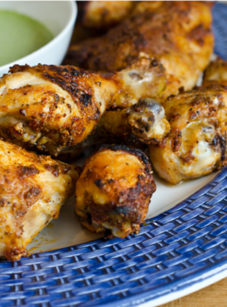

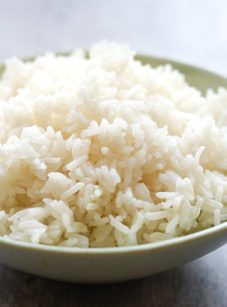

Quick question Jenn. I saw you used an induction portable in “My Videos” and I was wondering the make. It looks like it works with larger size pans? I’m looking for t would work with 10-12” pans. Thanks so much.
Hi Wendy, this is the cooktop from the video. 🙂
Made this just as it was written but halved the recipe. Turned out perfect. I wouldn’t change a thing. The sauce was rich and very tasty. The chicken skin was crispy! Thanks for another great recipe!
Question for Jenn: Was the rice vinegar you used seasoned or unseasoned? I’m assuming unseasoned (plain/natural). Rice vinegar is a regular staple in my cupboard so that’s what I plan to use rather than searching for Filipino vinegar which is probably hard to find.
Hi Eloise, Yes that’s correct – unseasoned. Enjoy!
Hi,
allergy to coconut milk, what do you recommend for substitute?
Thanks.
Hi Janis, I would use heavy cream. Hope that helps!
That is a LOT of sodium, probable from the soy sauce. How can we make i with less sodium? TIA
Hi Carol, You can try it with low-sodium soy sauce. Hope that helps!
Hi Jenn!
This recipe was absolutely amazing! Wondering if you think it would work with light coconut milk?
Thanks for such an excellent recipe. It’s going in the rotation!
So glad you liked it! I think it will work with light coconut milk — just keep in mind that it won’t be as creamy and the sauce won’t thicken quite as much. Please LMK how it turns out if you try it!
I only have used light coconut milk (canned from TJs) it is very creamy and rich regardless 🙂
I made this dish last night and it was delicious! My kids ate it up! I doubled the sauce, with just one can of coconut milk. I used Filipino vinegar as suggested by another commenter. I added whole peppercorns instead of ground pepper. I will definitely be making this again!
There are some tweaks I would do for next time. I would not sear the chicken thighs, as I felt it wasn’t necessary, and skip the marinading for an hr. This avoids a smokey soy sauce mess, and less time to prepare and cook. I would just put all the ingredients together on simmer until the meat fell off the bones. Other than that, the flavor profile was excellent!
This is a great adobo recipe. It’s the best version I’ve had in a long time. Can this be frozen for later?
Glad you like it! I haven’t frozen it myself, but I think you could.
I made this tonight and it is really flavorful. I did use Coconut Aminos instead of soy sauce, and used honey instead of sugar. My husband loved it, too. I will definitely make this again! 😋
I’m a Filipino and I thought this was a pretty great version of our national dish! If you can manage to find it in North America (usually in Filipino stores), use Datu Puti brand vinegar. It’s cane vinegar and is the best for adobo. It’s not too sharp/sour and is actually a bit sweeter. You might not need to use as much sugar with cane vinegar.
The coconut milk curdled
when mixed with vinegar. Did I do something wrong?
No, you didn’t do anything wrong. The acid in vinegar can cause the proteins in the coconut milk to separate, leading to a curdled appearance. To avoid this, try adding the vinegar more slowly next time. Hope the chicken came out well!